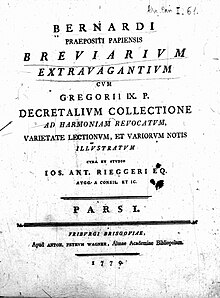Quinque Compilationes Antiquae

The Quinque Compilationes Antiquae are five collections of decretals that were created between the end of the 12th and the beginning of the 13th century . They were later replaced by the Liber Extra .
General
Within the numerous collections of decretals, there were five that held a special position, the so-called Quinque Compilationes Antiquae. They are called antiquae to distinguish them from the later Liber Extra . The numbering comes from the older decretalists and has been chosen according to systematic criteria. They are the only ones to whom the Bolognese School of Law has given general recognition.
Compilation great
The Compilatio I antiqua (also Breviarium extravagantium ) was created around 1191/92. These are addenda to the decree by collecting sources that were not used by Gratian . This was followed by the decretals of the post-Gratian era up to and including Clement III. on. In addition, there were council canons and pieces from Roman and Germanic law.
The collection is divided into five books and organized systematically: (Classification principle of Roman law)
- judex: papal government, d. H. Offices and administration
- judicium: procedural law
- clerus: spiritual and property law
- connubia: (sponsalia) marriage law
- crimen: criminal law and criminal procedure law
Clerus, sponsalia and crimen were classified in titles with headings (rubrics). Each title was broken down into chapters, chronologically ordered decretals or parts of such. This division became the model for most of the subsequent collections.
It is a private work by Bernhard Balbi von Pavia (death 1213), professor in Bologna and was adopted by the school. It should be for teaching and practice. The further development of the law prompted the creation of appendices and collections that wanted to supplement the Compilatio Prima.
Rainer von Pomposa , Gilbert (1202), Alanus Anglicus and Bernardus Compostellanus antiquus wrote the appendices. Bernardus Compostellanus antiquus presented a collection of the decretals of Innocent III. from the papal registers. However, it was not approved by Innocent and was given the name Compilatio Romana in Bologna.
Compilatio Secunda
The Compilatio II antiqua was created around 1210-1215, it was written by Johannes Galensis (John of Wales) in the 11th / 12th. Century. He was a master and professor in Bologna. It includes decretal offices of Popes Clement III. and Celestine III. (1191–1198) and sources that Bernhard von Pavia had left out in his Compilatio Prima, especially decretals of the pontificate of Alexander III. (1159-1181) and subsequent popes (1159-1187). It is based on collections by Gilbert and Alanus (13th century). It follows the principle of division into five books and is a private work and is taken over by the school.
Compilation Tertia
The Compilatio III antiqua was created in 1210 and was written by Petrus Collivaccinus Beneventanus (11th / 12th century). This was a notary of Pope Innocent III. (1198-1216). He was a master of the Bolognese school. It contains the decretals of the first 12 years of Innocent III's reign. (until 1209) and was sent with the Bulle Devotioni vestrae on December 28, 1210 to the masters and students of the school of Bologna and thus promulgated. This compilation thus became the first authentic collection of decretals, which thereby acquired universal legal force. The principle of division into five books also applies here.
Compilation Quarta
The Compilatio IV antiqua was created in 1216. It contains the decretals of Innocent III. the government years 1210-1216 and earlier, which were not included in the Compilatio Tertia. It contains the resolutions of the 4th Lateran Council (1215). The author was probably Johannes Teutonicus Zemeke (d. 1245/46). The collection, which follows the five-part division, was never promulgated. It is to be regarded as a private collection. Even so, it was very common in both church practice and law schools.
Compilation Quinta
The Compilatio V antiqua was compiled in 1226 by the Bolognese decretalist Tankred . It contains the decretals of Pope Honorius III. (1216–1227) until 1226 and an imperial constitution of Frederick II (1212–1250) from 1220 on various freedoms of the church. Honorius III. sent them to the Bolognese School with the bull Novae causarum of May 2, 1226; The Compilatio V was the second authentic collection of decretals of the Roman Church. The principle of division into five books also applies here. She received the greatest recognition.
Edition
- Emil Friedberg : Quinque compilationes antiquae. Leipzig 1882 (reprint 1956)
literature
- Willibald Plöchl : History of Canon Law. II. Volume. 2nd edition 1962
- Georg May : Theological Real Encyclopedia: Canon Law Sources I.
- Adalbert Erler : Canon Law. 5th edition. 1983
- Eduard Eichmann / Klaus Mörsdorf : Textbook of Church Law , Volume I, 6th Edition, 1951
- Johann Haring : Fundamentals of Catholic Church Law. 1st chapter. 1924
- Johann B. Sägmüller : Textbook of Catholic Church Law. I. Volume. 1914
- Godehard Josef Ebers : Outline of Catholic Church Law. 1950
- Hans Erich Feine : Church legal history. 4th edition. 1964